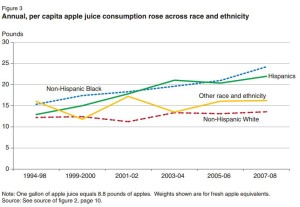
What do Americans eat? It’s hard to say.
I’ve just received a new report from USDA’s Economic Research Service, U.S. Food Commodity Consumption Broken Down by Demographics. This looks at trends in per capita food availability—the amounts of specific foods available in the food supply, obtained from data on production and imports, from 1994 to 2008, corrected for waste, per person in the United States.
Food availability data, especially when corrected for waste, suggest trends in per capita consumption patterns (otherwise why would USDA bother to collect them?), but they are not consumption data. They are about supply, not use.
With that said, the trends seem odd to me. They demonstrate a decline in the availability of:
- Fruit (mainly oranges)
- Vegetables
- Dairy (mainly milk)
- Beef
- Pork
- Potatoes
- Sugars
The supply of yogurt and cheese, however, has increased (but their per capita availability is relatively low).
The supply of apple juice also has increased:

Food availability data corrected for waste are supposed to come close to what people actually eat. But if people are eating less of practically all foods, how come so many of us are still gaining weight? Surely it’s not because of apple juice.
These data are an important source of information on U.S. dietary patterns.
But what do they mean? The authors do not say, so it’s left to us to figure that out.
As I keep saying, finding out what people eat is the single most intellectually challenging problem in the field of nutrition.

